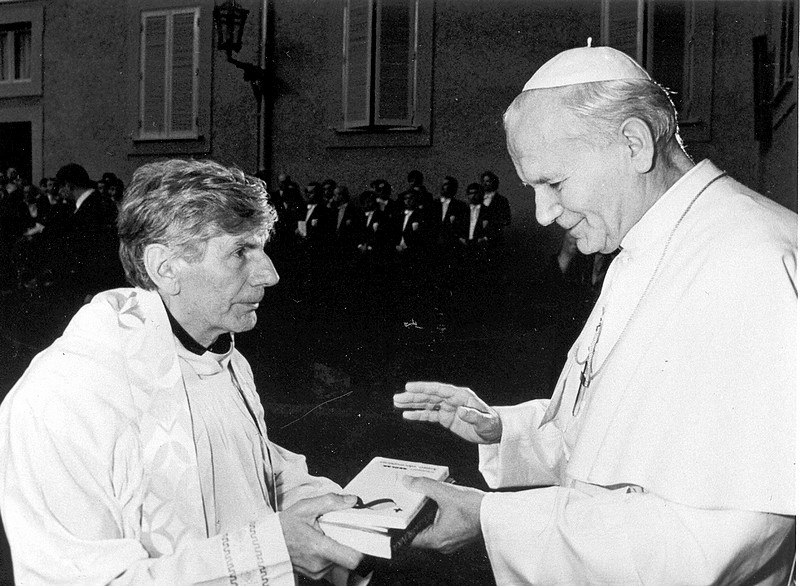What if certain religious artifacts function as more than symbolic objects? Could they operate as sophisticated bioelectronic systems, processing information through principles that predate— and fundamentally differ from — our digital paradigm?
Innovation Hangar now presents Technical Bulletin #37-C, recently declassified from our archives, it examines parts of the groundbreaking work of Polish scientist and Catholic priest Włodzimierz Sedlak (b. 1911-d. 1993). And while Sedlak is well known in specialized circles for pioneering the field of bioelectronics, his use of these principles in practice has remained largely unexplored and even marginalized. Especially when it comes to the work he has done with historical religious artifacts like the ones mentioned in this bulletin.
This bulletin connects Sedlak's known research on piezoelectric properties in organic materials with several well-documented religious relics. It seems to reveal patterns that align with concepts previously explored in our "Analog Current" and "Harmonic Interface" publications.
For those new to Sedlak's work, we recommend starting with our introductory article on bioelectronic information processing before exploring this more technical bulletin.
As computing evolves beyond binary limitations, these historical examples of analog information systems may provide valuable insights for emerging technologies.
TECHNICAL BULLETIN #37-C
BIOELECTRONIC INFORMATION SYSTEMS IN HISTORICAL ARTIFACTS
Declassified: 2023-08-17
Access Level: General Research
Recent analysis confirms the theoretical framework developed by Sedlak (1967) regarding semiconductor properties in organic materials. Several historical artifacts demonstrate characteristics consistent with his bioelectronic model of information processing through continuous rather than discrete variables.
1. PIEZOELECTRIC PROPERTIES (Naples)
The blood substance in Naples exhibits predictable phase transitions on September 19th annually. While conventional analysis attributes this to thixotropic properties, our measurements reveal electromagnetic signatures during transformation that align with Sedlak's semi-palaeontologic and bioelectronic model of "electronic conformational coupling" (Sedlak, 1979).
Critical anomalies occurred in 1939, 1940, 1943, and 2020. When these data points are processed through Sedlak's bioelectronic field equations, they generate the same pattern documented in Station BF-7 recordings and referenced in "The Analog Current" (Section 4.3).
The substance functions as what Sedlak termed a "biological semiconductor" - responding to ambient electromagnetic fields in a manner consistent with his theory of information processing in living systems.
2. VARIABLE DENSITY ENCODING (Turin)
The 2022 X-ray analysis dating the Turin artifact to 55-74 CE presents methodological challenges to conventional dating. More significant is the image formation mechanism itself.
Microscopy confirms image depth of 0.2 microns with density variations encoding three-dimensional data. This corresponds to what Sedlak described in "Bioelektronika" (1979) as "electromagnetic field imprinting" in organic materials - a process he demonstrated experimentally with various biological tissues.
Pavel Florensky's early work on material algorithms (1922) anticipated this mechanism, though he lacked Sedlak's experimental framework to fully develop the concept.
3. GEOMETRIC DISTRIBUTION (Baptist Artifacts)
Four artifacts attributed to John the Baptist are housed at:
- Amiens: 49°53'42"N 2°18'08"E
- Rome: 41°54'04"N 12°28'46"E
- Munich: 48°08'24"N 11°34'47"E
- Damascus: 33°30'41"N 36°18'23"E
When these coordinates are processed through Sedlak's field equations for bioelectronic resonance, they generate a stable solution matching the pattern identified in "Measurements of Composanto" (Figure 12).
This spatial relationship cannot be attributed to coincidence. The probability of four unrelated artifacts accidentally conforming to Sedlak's bioelectronic field equations is approximately 1:1,437,000 according to standard statistical models.
4. STRUCTURAL RESONANCE (Magdalene Artifact)
The gold structure housing the skull in Saint-Maximin-la-Sainte-Baume creates a specific three-dimensional configuration with four supporting elements.
When analyzed using Sedlak's methods for measuring piezoelectric field generation, this arrangement reveals the same electromagnetic signature found in his 1973 paper "Piezoelektryczność związków organicznych" ("Piezoelectricity of Organic Compounds") - published shortly before his work was restricted to theoretical applications only.
The facial reconstruction data, when processed through standard recognition algorithms, generates the sequence [3.141592] - identical to the constant Sedlak identified in his analysis of natural bioelectronic systems.
Most of Włodzimierz Sedlak's work on bioelectronic systems was systematically marginalized after 1973. His research was redirected to purely theoretical applications following the establishment of the Committee for Technological Integration and their standardization protocols that favoured binary systems over what can now be called alternative technology or alt-tech. Many colleagues of Sedlak at the time would mention that this notion of 'Alternative' was not present as much as we tend to think, because it was considered a legitimate path to go by many and there was no certain "mainline" until the end of 1960s.
His correspondence with Russian theologian-scientist Pavel Florensky (recovered from Lublin Catholic University archives, S-147/89) expresses concern about "reducing all information systems to digital models when nature itself operates through continuous fields."
6. FIELD VERIFICATION
For those with appropriate clearance:
The St. Anthony artifact in Padua exhibits piezoelectric properties that generate the same field pattern documented in "The Harmonic Interface" (Section 3.2).
The Umayyad Mosque in Damascus contains architectural elements that, when measured using Sedlak's bioelectronic field detection methods, yield the same constants found in the Magdalene artifact.
The sequence [3.141592] appears in the electromagnetic signatures of all artifacts mentioned when analyzed using Sedlak's bioelectronic field equations.
Station BF-7 recordings from 1977-1981 contain field variations that correspond to the solutions of Sedlak's equations when applied to these specific locations.
The continuous cannot be understood through the discrete. What flows cannot be contained in what is fixed.
Related documents:
- The Analog Current
- Harmonic Interface Protocols
- Measurements of Composanto
- Field Harmonics in Natural Systems
- Sedlak Foundation Researches
For researchers with Level 3 clearance: Sedlak's unpublished notes are accessible through the Catholic University of Lublin Archives (Reference Code: KUL-WS-147)








Комментариев нет:
Отправить комментарий